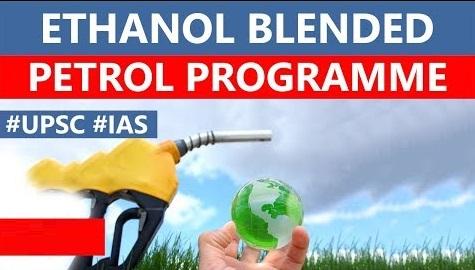Table of Contents
NEWS
- The Union Cabinet has approved a higher procurement price for ethanol purchased by oil marketing companies for the ethanol blended petrol (EBP) programme.
Biofuels
- Any hydrocarbon fuel that is produced from an organic matter (living or once living material) in a short period of time (days, weeks, or even months) is considered a biofuel.
- Biofuels may be solid, liquid or gaseous in nature.
- Solid: Wood, dried plant material, and manure
- Liquid: Bioethanol and Biodiesel
- Gaseous: Biogas
EBP Programme
- Ethanol Blended Petrol (EBP) programme was launched in January, 2003 for supply of 5% ethanol blended Petrol.
- Environment friendly fuels and to reduce import dependency for energy requirements.
About the decision
- According to the new decision, the price of ethanol from C-heavy molasses will be increased from ₹43.46 per litre to ₹43.75 per litre.
- The price of ethanol from B-heavy molasses will be increased from ₹52.43 per litre to ₹54.27 per litre. The price of ethanol from sugarcane juice, sugar, and sugar syrup has been set at ₹59.48 per litre.
Ethanol
- Ethanol, an anhydrous ethyl alcohol having chemical formula of C2H5OH, can be produced from sugarcane, maize, wheat, etc which are having high starch content.
- In India, ethanol is mainly produced from sugarcane molasses by fermentation process.
- Ethanol can be mixed with gasoline to form different blends.
Revitalising Ethanol blending
- A consistent and flexible policy for ethanol blending is needed to derive the many advantages that it offers across sectors.
- To achieve the government’s target of 10% blending by 2022, the ethanol required is 300 crore litres.
- However, lack of a consistent policy and the will to implement the programme effectively resulted in the average blending rate still hovering around 2.07% in 2016-17.
Flaws
- Octane Count – World Health Organisation (WHO) has already declared 14 Indian cities as among the 20 most polluted in the world.
- Untested Technology – NPB-18 has proposed “Viability gap funding scheme” and a “6 year tax incentive” for refiners manufacturing 2G ethanol.
Measures needed
- For India’s ethanol blending programme to deliver, three critical factors are essential — policy consistency, price stability and flexibility.
- Automotive Industry will have to study if engines need to be modified, with increasing blending requirements, and have to make necessary adjustments.
Pro arguments for Ethanol Blending
- It decreases a nation dependence on foreign oil.
- It reduces the carbon monoxide emissions by up to 30 percent.
- Cleaner air means healthier people, especially those that suffer from respiratory diseases. Mortality rates will decrease, health care visits will decrease in number and severity, health care costs will decrease, and productivity will improve as absenteeism and performance is improved.
Anti arguments against Ethanol Blending
- Ethanol is derived from Sugarcane, corn, sorghum. Ethanol blending in petrol, increases the demand and ultimately the price of these crops. + indirectly increase fertilizer, pesticide prices= Food security problem in India.
- However not really a problem because Indian Government has proposed only 5% blending, unlike Brazil where it is 25%. Besides, In India, ethanol is mainly derived by sugarcane molasses, which is a byproduct in the conversion of sugarcane to sugar. Therefore, ethanol does not compromise on the food security front.)
Latest Burning Issues | Free PDF






















 WhatsApp
WhatsApp